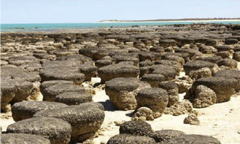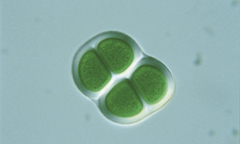
Campus Moncloa
Campus of International Excellence
Archean
4000-2500 M.a.
Archean, from the Greek term for origin.
The oldest preserved rocks of terrestrial origin come from this age. The Earth's surface cools down and the first continents are formed – they are much smaller than those that currently exist. Volcanic gases result in a primitive atmosphere rich in methane, carbon dioxide and water vapour, but no free oxygen. When the surface cools the water vapour condenses and gives rise to the first oceans.
Las rocas arcaicas registran la presencia de vida desde hace 3.500 M.a., son los primeros fósiles de organismos procariotas (células sin núcleo diferenciado), que se disponen en formaciones laminares llamadas estromatolitos. Al comienzo, los organismos quimiosintéticos debieron ser los más abundantes, pero pronto aparecen los primeros organismos fotosintéticos (cianobacterias) capaces de usar la luz del Sol como fuente de energía para sus funciones vitales. Este proceso resultará fundamental para la historia de la Biosfera.

Stromatolites at Hamelin Pool (Australia).

Organisms similar to this cyanobacteria proliferated in the Archean.
| Hadean | ~4600-4000 M.a. |
| Archean | 4000-2500 M.a. |
| Proterozoic | 2500-541 M.a. |
| Cambrian | 541-485 M.a. |
| Ordovician | 485-443 M.a. |
| Silurian | 443-419 M.a. |
| Devonian | 419-359 M.a. |
| Carboniferous | 359-299 M.a. |
| Permian | 299-252 M.a. |
| Triassic | 252-201 M.a. |
| Jurassic | 201-145 M.a. |
| Cretaceous | 145-66 M.a. |
| Paleogene | 66-23 M.a. |
| Neogene | 23-2,6 M.a. |
| Quaternary | 2,6 M.a.-act. |
